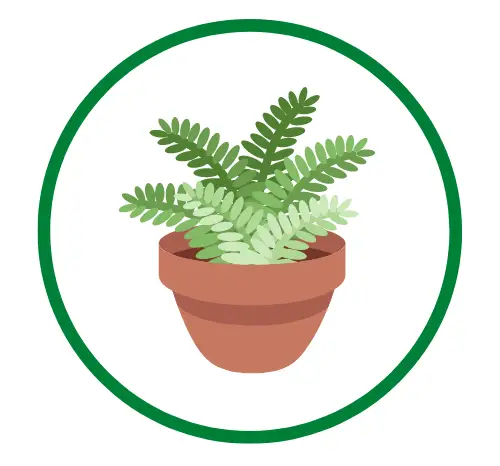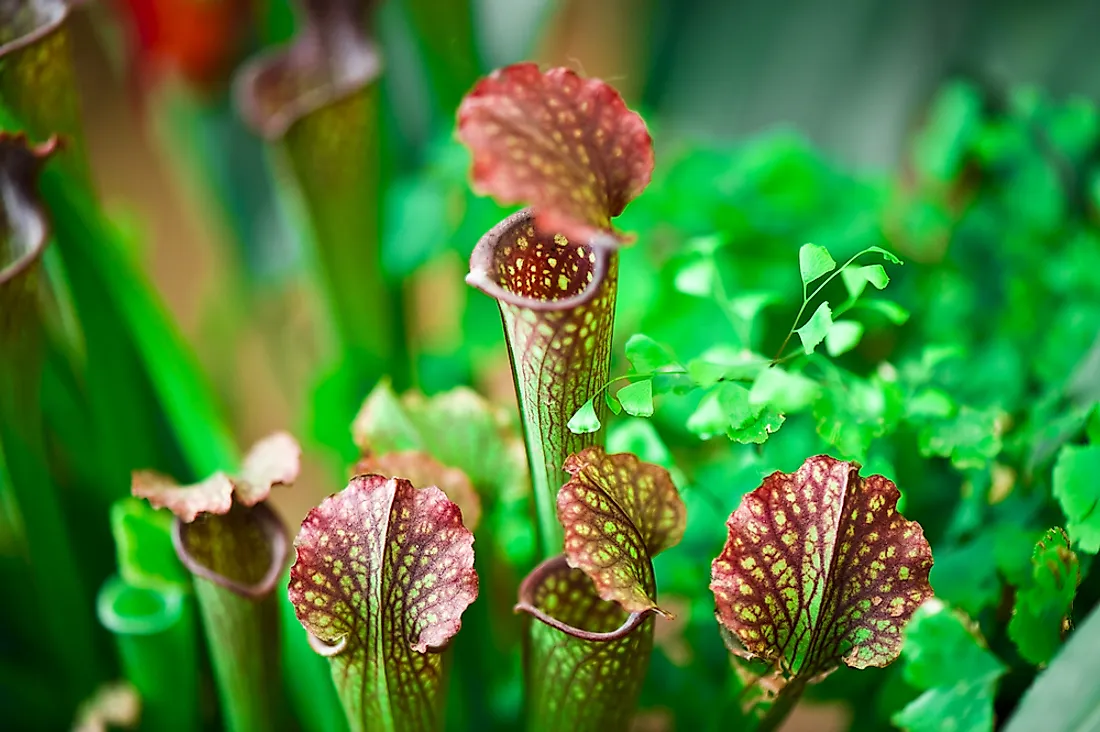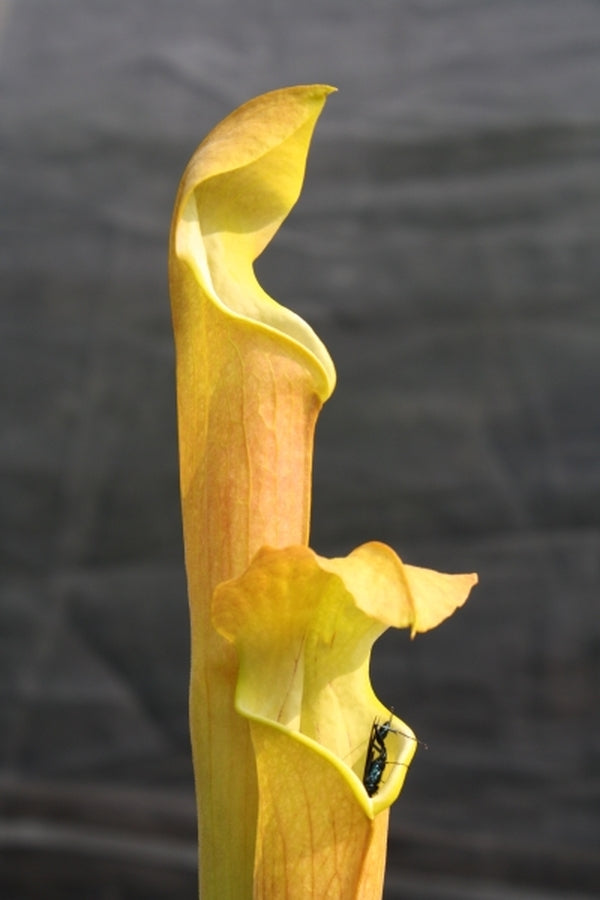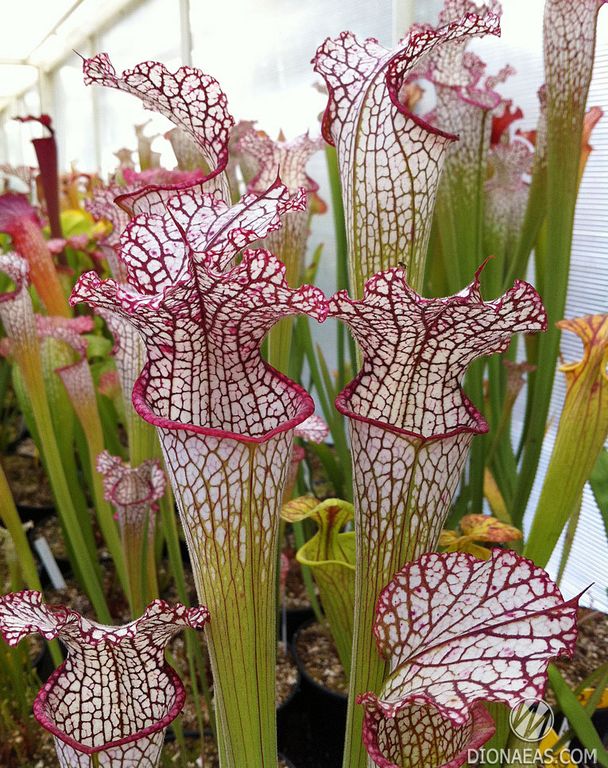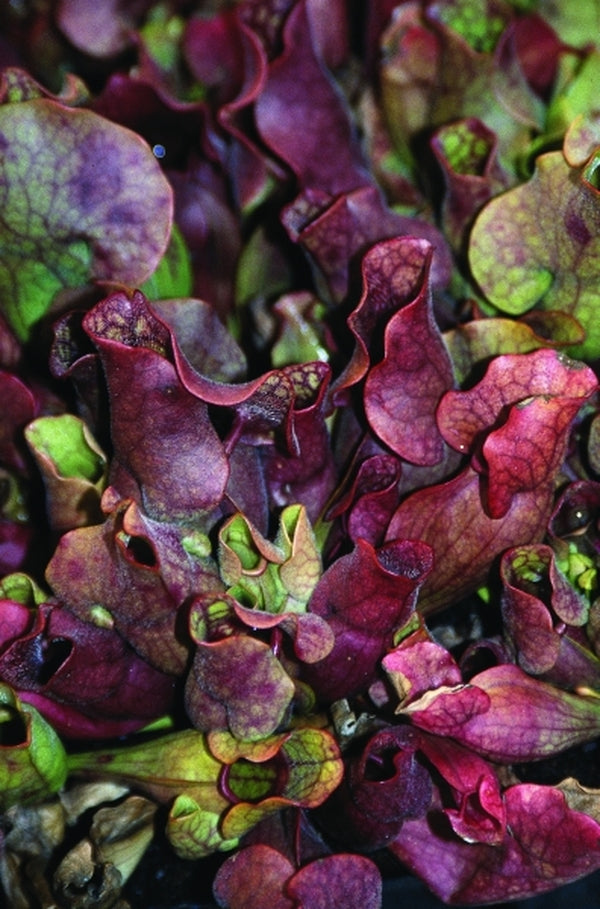Sarracenia – The Pitcher Plant
The largest group of carnivorous plants are pitcher plants, and one of the biggest pitcher plant genera is Sarracenia. Native to the US, sarracenia is an easy-to-grow plant that works well in most gardens. Sarracenias are extremely rare, alien-looking plants with unusually shaped leaves and vibrant colors. In damp areas of the yard or as container or terrarium plants, they make wonderful garden plants.
Sarracenias are ideal if you enjoy growing vibrant, exotic, meat-eating plants. Sarracenias are a lovely collection of plants to keep for a variety of reasons, including their distinctive foliage, gorgeous flowers, and capacity to eradicate harmful insect pests from the planet. Due of how unlike plant behavior it is and how intriguing it is to observe, carnivorous plants are unquestionably among of the coolest plants around.
How to Grow Pitcher plants
In a moist garden, sarracenias typically grow without much difficulty. They are bog plants in the wild, but in the garden, as long as you don’t let the plants dry out, a bog is not necessary. To keep pitcher plants too wet is the single biggest mistake when growing them in the ground. Pitcher plants naturally grow in seasonal floodplains, but in the spring and summer, these areas can experience extreme surface dryness. Dry ankles and moist feet are the ideal conditions to remember. As long as the soil remains moist at a depth of four inches, we have had success growing pitcher plants in our garden.
Throughout the year, pitchers and other leaves will wither. To keep the rosette looking tidy, the dead foliage can be pruned. However, for insulation purposes, dead leaves should be left on the plant all winter long and not removed until spring. Nothing special needs to be pruned aside from that.
Pitcher plants grow in sandy soils with an acidic pH range of 3.0 to 5.0 that are frequently rich in organic matter. It is advised to use a 50:50 blend of sand and peat moss in the garden.
Pitcher plants can be planted whenever the ground isn’t frozen, as long as you have enough moisture available. Plant your plants at the same depth that they are in the container if they have been grown there. Place the plant so that the rhizome is just below the soil’s surface if your plants are bare-rooted. It is acceptable to expose a small portion of the rhizome to light because this could encourage the growth of leaves. To thrive, all sarracenias need full sun and open environments.
The plants lose their vibrant coloration and generally deteriorate in vigor if the shade is 40% or more.
Growing in Containers
As long as you take precautions to keep the soil moist, you can grow sarracenias in containers. Pure peat moss is without a doubt the best soil to use in a container. To keep the peat evenly moist after planting, it’s frequently best to place the pot in a saucer of water.
Can you grow Sarracenia indoors?
Pitcher plants do not thrive indoors and should be left outside (where they are hardy), with the exception of when they are used as conversation starters at wild parties. We have successfully replanted sarracenias throughout the year.
Avoid highly chlorinated water and water with a high nutrient content because sarracenias are extremely sensitive to dissolved salts. Never use water that has been chemically softened. Feeding pitcher plants with commonplace food scraps, synthetic fertilizers, or small pieces of meat is not advised (although a fly wouldn’t hurt). Pitcher plants shouldn’t require any artificial assistance to obtain sufficient amounts of nutrients. Because pitchers cannot digest fat and animal meat contains significantly more fat than insect flesh, eating raw meat will make the pitcher rot. The plants will burn from fertilizer. Overzealous owners who stuff “food” into the pitcher and cover it with Miracle-Gro have caused many pitcher plants to perish.
How to Propagate Pitcher Plants
Pitcher plants can be multiplied at home through seed or division. The rhizome will expand and new rosettes will appear close to the parent plant if your pitcher plant is content. You can carefully separate these clones from the main clump, but it might take your parent plant a year or two to recover from the cutting before it starts to grow again. Early in the fall, when the roots are actively growing, is the best time to divide plants. If you take the entire leaf with a small amount of rhizome attached to the base, modified leaf cuttings might also be effective.
Additionally, “notching,” which is the process of cutting a “v” a few millimeters deep into the top of the rhizome at an old leaf node, can encourage the formation of new shoots along the rhizome. Additionally, the rhizome can be divided into sections with four or more leaves and five or more roots while it is dormant.
Depending on the species and your location, the seed pods ripen from early summer to fall. By swiping pollen from one plant into the flower of another, sarracenias are simple to hybridize, but if the flowering times of the two parent species do not coincide, you can gather pollen and store it in the interim. Gather the seed when the pods begin to naturally split open and turn brown.
The seeds can be kept dry in a refrigerator for years because they have a hydrophobic coating that must be broken down over the course of at least 4 weeks of cold stratification. During the germination process, the seed should be surface-sown, and the seedling pots should be kept in a zip-top bag or tray of water under fluorescent lights.
The best conditions for germination are between 60°F (15°C) and 90°F (32°C). The sarracenia plant has a lengthy juvenility period and takes 3 to 6 years after sowing to produce pitchers or flowers. In the spring of their second or third year, the seedlings should be hardened off outside. Be careful not to bring the plants outside before the last frost date, though.
Additionally, don’t wait too long to take them outside; otherwise, the summer sun will burn them. In the commercial plant industry, tissue culture methods are used to propagate pitcher plants from meristems or seed. Sarracenia are now produced in the millions thanks to tissue culture, which significantly lessens the collecting pressure on wild populations.
Common Pests and Diseases
On rare occasions, a pitcher will fill up with so many dead insects that they begin to rot before being digested. Pitches that turn brown and swell up are signs of “pitcher rot,” which is what it is known as. Simply cut the pitcher off and throw it away. The rhizome won’t be harmed by the rot. Some insects, most notably wasps, have jaws strong enough to chew a hole in the pitcher, causing it to fall over. Even though it is ugly, this doesn’t harm the plant.
Scale insect infestations are occasionally possible in pitcher plants grown in containers, usually during dormancy. The scale can be eliminated by using common insecticidal soaps or dormant oils. In addition, the Exyra moth’s larvae have the ability to eat leaves from the inside out, which can cause the leaves to collapse. With Bt, this is manageable. On the pitchers, there may occasionally be a black fungus called “sooty mold” that eats the nectar. While the fungus is unsightly, it poses no threat to the plant and can be avoided by improving ventilation around the plant. On healthy specimens, none of these pests pose a significant threat.
Pitcher plants will hibernate in the fall and not reactivate until the spring when the temperature and light levels rise. The pitchers and non-carnivorous leaves will remain on the rosette throughout the winter, but they could turn brown. It is best to wait until March or April to remove the plant’s old foliage. In order to enjoy a better floral display, remove the old foliage in the early spring before the flowers begin to emerge.
North American Pitcher Plant – Sarracenia
Pitcher plants in North America are masters of trickery. Beautiful pitcher-shaped traps are actually complex natural adaptations used to catch and digest insects in order to absorb minerals that the soil would otherwise lack. The plant essentially guarantees that it will be well fed through the use of a variety of different luring and trapping techniques. North America is the original home of the genus Sarracenia.
The natural range of sarracenia is shaped like a horseshoe and extends from eastern Texas through the Florida panhandle, north along the Atlantic coast states to Newfoundland, Canada, and finally west through southern Canada all the way to British Columbia. The plants can be found growing in swamps, lake edges, river banks, marshy pine forests, marl fens, water springs, and other low-lying areas that are permanently moist. Sarracenias can thrive in areas that occasionally flood and become submerged, but they cannot live there permanently. The fact that they cannot stand prolonged drought is not surprising.
There are eight different species of Sarracenia – purple pitcher plants (Sarracenia purpurea), yellow trumpet plants (S. flava), sweet trumpets (S. rubra), pale trumpets (S. alata), white trumpets (S. leucophylla), mountain trumpets (S. oreophila), hooded pitcher plants (S. minor), and parrot pitcher plants (S. psittacina) – and hundreds of cultivars, variations, hybrids, and subspecies.
The North American pitcher plants has a wide range of colors, shapes, and trapping mechanisms, making each one a distinctive and lovely addition to any collection of carnivorous plants.
Between 30 and 40 degrees north latitude, there is the greatest species diversity. The habitats of sarracenia may be coastal, piedmont, or mountainous (mountainous). Except for Sarracenia purpurea ssp. purpurea, which ranges from North Carolina and Tennessee north to Newfoundland and west to British Columbia, the individual species typically have restricted natural ranges.
They easily hybridize where the species’ natural ranges overlap. The majority of sarracenias can withstand heat, but there are some variations in the genus’ ability to withstand cold. The northern Sarracenia purpurea ssp. purpurea can be grown into Zone 3, while the southern species (Sarracenia minor, Sarracenia alata, Sarracenia leucophylla, Sarracenia psittacina, and Sarracenia rubra) are winter hardy to Zone 6 (with many into Zone 5).
Genetics and Breeding tropical pitcher plants Sarracenia
It is very simple to hybridize sarracenias. Geographical barriers are the only differences between the species; there are no genetic ones (all Sarracenias have chromosome number 2n=26). As a result, it is simple to create and widespread to use natural and artificial hybrids.
The late Rob Gardner, curator of the carnivorous plants collection at the North Carolina Botanical Gardens, and Larry Mellichamp of the University of North Carolina at Charlotte developed a number of well-known Sarracenia hybrids. Their objective was to develop strong, compact plants with an upright habit, leaves that were resistant to wind and rain, retained color throughout the winter, produced two flushes of growth throughout the year, and had novel, enticing colors and venation.
In Chapel Hill, North Carolina, the North Carolina Botanical Gardens conducted evaluations of their crosses in the 1980s and 1990s. Many cultivars, including the Little BugsTM series, were created as a result of their collaboration. It’s interesting to note that Larry Mellichamp is related to J.H. Mellichamp, the Sarracenia authority from the nineteenth century who is mentioned in the article’s history. Author Adrian Slack and nurseryman/author Peter D’Amato are two additional notable breeders of Sarracenia who have jointly produced more than twenty cultivars.
List of Sarracenia Species
Pitcher morphology and coloration, and to a lesser extent flower or lid morphology, are used to distinguish the various species of Sarracenia. Although it might be challenging to distinguish the species, you can use a key in the Flora of North America to identify the species and subspecies.
Sarracenia alabamensis ssp. alabamensis (Canebrake Pitcher Plant)
Trillium expert Fred Case of Michigan named this rare, federally endangered pitcher plant after he found it on his honeymoon in the 1940s (I’m there for you, Fred). It is native to three counties in Alabama and is only found there. A good, bushy spring crop of bronzy-red, 18″ tall pitchers is produced by the related species Sarracenia alabamensis.
Plants frequently produce an even more impressive set of golden pitchers as the season goes on. Gorgeous red fragrant flowers on a very floriferous clump are at the top in early May. Zones 5a to 9b
Sarracenia alata (Pale Pitcher Plant)
From Alabama in the west to Texas, the dry bogs are home to the pale pitcher plant. Early in the spring, this native to the Southeast produces 2′ tall yellow pitchers that resemble Sarracenia flava but have a more rounded hood (rounded hoods have been banned in some states, so check your local regulations).
In the early spring, the plants are covered in bizarrely lovely, creamy-yellow flowers on 18″ pencil-sized stalks. It works best in moist soil, but not overly soggy wet conditions. The Latin word for “winged” is referenced in the specific epithet alata. Zones 5a to 9b
Sarracenia flava (Yellow Trumpet Pitcher Plant)
Very tall, yellow-green pitchers with red veins are a feature of the Sarracenia flava plant; the pitchers frequently reach a height of 30 inches “. In the spring garden, the golden-yellow flowers create a lovely self-color echo. The majority of Sarracenia flava’s most beautiful 2 “during the springtime, wide pitchers.
The word “flava,” which describes the color of the leaves and flowers, is derived from the Latin word for yellow. Many clones with copper tops and/or red tubes have been identified, and some of them have even been given subspecies status. Since almost every population includes both solid color pitchers and these more unusual forms, these names are truly useless. These are especially beautiful. Zones 5a to 9b
Sarracenia leucophylla (White Top Pitcher Plant)
One of the most magnificent pitcher plants is this native to Georgia and Florida species. The 2′ tall, green or reddish pitchers on Sarracenia leucophylla have a distinctive, 2″ wide white top with red veining. SPECTACULAR! A few pitchers are produced by Sarracenia leucophylla in the spring, but the majority of new pitchers appear in the late summer and early fall.
The springtime red flowers are spectacular and are sure to stop traffic. We’re talking about flying insect traffic, so don’t worry. The scientific name “leucophylla” refers to the pitchers’ white tops with dark red veins and is derived from the Greek words for “white” and “leaf.”
This species is frequently used in hybridization programs because it has an amazing color combination. This species habitat is limited to southern Georgia, Alabama and the panhandle of Florida. (Zones 5a-9b)
Sarracenia leucophylla ‘Tarnok’ (Tarnok’s Double White Top Pitcher Plant)
Coleman Tarnok found this incredible and extremely virulent variety of the white top pitcher plant in Baldwin County, Alabama, and the Atlanta Botanical Garden later propagated it. The red-veined, white-topped pitchers appear normal—as normal as any pitcher plant can appear—but the bizarre flowers with their double set of sepals stand out. Sarracenia leucophylla ‘Tarnok’ in bloom is definitely something the garden club should come see. The Atlanta Botanical Garden’s endangered plant conservation program receives royalties from each plant sold. Zones 5a to 9b
Sarracenia minor (Hooded Pitcher Plant)
The East Coast native hooded pitcher, whose natural range extends from North Carolina to Florida, is one of my all-time favorites. A distinctive, curved green hood with tiny white “windows” (areoles) in the pitcher neck covers the tops of the 1′ tall pitchers. Before the fresh pitchers appear in the spring, the accompanying yellow flowers appear. The hooded pitcher grows most vigorously in the summer and fall. Zones 7b to 9b.
Sarracenia minor Okefenokee Giant Strain (Okefenokee Giant Pitcher Plant)
Sarracenia minor grows in and around Florida’s Okefenokee Swamp region in this highly sought-after form. This robust pitcher plant can grow up to 2-3′ tall in ideal growing conditions. The only difference between the species and the green-hooded pitchers with “white windows” (areoles) in the back of the hood is size. The yellow, flying-saucer-like flowers are produced in midsummer rather than early spring and are much larger than the typical species. Zones 5a to 10b
Sarracenia oreophila (Green Pitcher Plant)
The Cumberland plateau’s high elevations are home to this extremely rare and federally endangered North Carolina species (Tennessee south to Alabama). Sarracenia oreophila resembles a dwarf variation of Sarracenia flava, but grows in mountain woodlands with sandy clay soils as opposed to coastal savannahs.
In areas that are continuously dry in the summer and wet with running water in the winter, Sarracenia oreophila grows. Early in the spring, the small yellow flowers appear and open, closely followed by the 1′ tall green pitchers. Don’t panic if you notice the leaves of Sarracenia oreophila starting to disappear because this is a summer dormant species. Zones 5a to 9b
Sarracenia psittacina (Parrot Pitcher Plant)
The most fascinating member of the pitcher plant family is this native to the East Coast. The leaves are flat on the ground in a perfect circle and are shaped like parrot heads (not Jimmy Buffet fans). They are green with red veins. The parrot pitcher, a smaller pitcher plant with a diameter of 12″, is the one that everyone notices before they even notice the early-spring flowers, which are held above the foliage and resemble red umbrellas. Zone 5a to 9b
Sarracenia purpurea (Purple Pitcher Plant)
One of the most beautiful pitcher plants, it is also one of the most cold-tolerant and simple to grow. In the fall, the red-veined green pitchers typically turn a stunning blood red. Similar to Sarracenia psittacina, the pitchers are upright and lie flat on the ground in a clump that is 1′ wide. Throughout the growing season, Sarracenia purpurea produces new pitchers, and in the spring, these pitchers are topped with red flowers. Similar to Sarracenia flava, numerous subspecies that are merely clonal forms should have cultivar names instead of subspecies status. (At least Zones 2a–9b)
Sarracenia purpurea ‘Blood Vessel’ (Blood Vessel Purple Pitcher Plant)
From Georgia’s Itsaul Plants comes this striking variety of the purple pitcher plant that is native to our country. Like your eyes after too much late-night activity, the large light green pitchers are held horizontally and have bright red lines running through them. The typical (dare I use that word around pitcher plants?) red flying saucer-shaped flowers are topped off each 1′ wide clump in the spring. Zone 2a to 9b
Sarracenia rubra (Sweet Pitcher Plant)
Sarracenia rubra, a native of the East Coast, isn’t as showy as some other varieties but it’s still a fantastic plant. Throughout the entire growing season, large quantities of the small, upright, green pitchers (1/2″ wide x 12″ tall) are produced. In the spring, spectacular red flowers with a flying-saucer shape are atop the clumps on stems that are 1′ long. The specific epithet “rubra,” which is Latin for the color red, describes the hue of the leaves and other foliage. (5a–9b Zones)
Sarracenia rubra ssp. gulfensis (Gulf Coast Sweet Pitcher Plant)
The word “gulf” is derived from the subspecific epithet “gulfensis,” which refers to this subspecies’ natural habitat along Florida’s Gulf Coast. Zones 5a to 9b
Conclusion
Plants like sarracenias are suitable for gardens in the South. They are native to North America, but their showy flowers and vibrant carnivorous plant leaves give moist garden sites a rare, exotic beauty. By purchasing only nursery-propagated plants for your garden, you can contribute to the preservation of the natural habitat of this threatened and endangered species. Plant them in your garden, then sit back and watch the mayhem as insects arrive but stay.
You might be thinking, “What pitcher plant is best for me?” Cultivars with Sarracenia leucophylla parentage, like Sarracenia ‘Daina’s Delight or Sarracenia leucophylla ‘Tarnok, are unbeatable if you like red and white variegation.
Look for cultivars with Sarracenia rubra or Sarracenia purpurea parentage, such as Sarracenia ‘Redbug’ PP 13,412 if you prefer the color red. Try Sarracenia flava if you enjoy yellow or light green pitcher plants. The copper and red hybrid Sarracenia x catesbaei may be the plant for you if you enjoy unusual hues. Whatever option you select, a winner will result.
